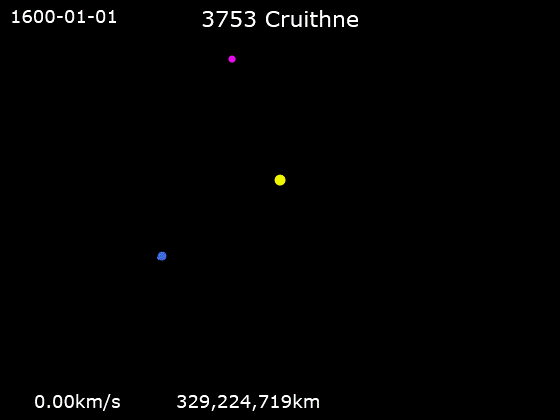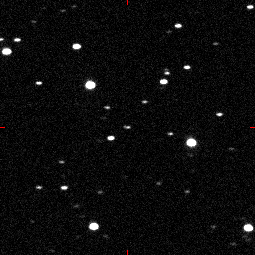|
Mars-crossing Asteroids
A Mars-crossing asteroid (MCA, also Mars-crosser, MC) is an asteroid whose orbit crosses that of Mars. Some Mars-crossers numbered below 100000 are listed here. They include the two numbered Mars trojans 5261 Eureka and . Many databases, for instance the JPL Small-Body Database (JPL SBDB), only list asteroids with a perihelion greater than 1.3 AU as Mars-crossers. An asteroid with a perihelion less than this is classed as a near-Earth object even though it is crossing the orbit of Mars as well as crossing (or coming near to) that of Earth. Nevertheless, these objects are listed on this page. A grazer is an object with a perihelion below the aphelion of Mars (1.67 AU) but above the Martian perihelion (1.38 AU). The JPL SBDB lists 13,500 Mars-crossing asteroids. Only 18 MCAs are brighter than absolute magnitude (H) 12.5, which typically makes these asteroids with H<12.5 more than 13 km in diameter depending on the |
(10302) 1989 ML
(10302) 1989 ML is an as yet unnamed near-Earth asteroid. It is approximately 0.6 km in diameter. An Amor asteroid, it orbits between Earth and Mars. It is an X-type asteroid, so its surface composition is yet unknown. It was discovered by Eleanor F. Helin and Jeff T. Alu at Palomar Observatory on 29 June 1989. Targeting by spacecraft The delta-v ('effort') required to reach 1989 ML from a low-Earth orbit is only 4.8 km/s, ranking fifth (as of March 2007) amongst the near-Earth asteroids with well-established orbits. 1989 ML is thus particularly 'easy' (and 'cheap') to reach by spacecraft. 1989 ML was considered as a target of the Japanese spacecraft Hayabusa (then Muses-C) but had to be given up due to technical reasons. It was also considered by the European Space Agency as a candidate target for the Don Quijote Don, don or DON and variants may refer to: Places *County Donegal, Ireland, Chapman code DON *Don (river), a river in European Russia *Don River ( ... [...More Info...] [...Related Items...] OR: [Wikipedia] [Google] [Baidu] |
4581 Asclepius
4581 Asclepius , provisional designation , is a sub-kilometer-sized asteroid, classified as near-Earth object and potentially hazardous asteroid of the Apollo group that makes close orbital passes with Earth. Discovered on 31 March 1989 by American astronomers Henry Holt and Norman Thomas at Palomar Observatory, Asclepius is named after the Greek demigod of medicine and healing. Asclepius passed by Earth on 22 March 1989 at a distance of . Although this exceeds the Moon's orbital radius, the close pass received attention at that time. "On the cosmic scale of things, that was a close call", said Dr. Henry Holt. Geophysicists estimate that collision In physics, a collision is any event in which two or more bodies exert forces on each other in a relatively short time. Although the most common use of the word ''collision'' refers to incidents in which two or more objects collide with great fo ... with Asclepius would release energy comparable to the explosion of a 600 megaton ... [...More Info...] [...Related Items...] OR: [Wikipedia] [Google] [Baidu] |
4034 Vishnu
4034 Vishnu ('' prov. designation:'' ) is a rare-type asteroid classified as near-Earth object and potentially hazardous asteroid of the Apollo group, approximately in diameter. It was discovered on 2 August 1986, by American astronomer Eleanor Helin at Palomar Observatory in California, United States. It is named after the Hindu deity Vishnu. Naming This minor planet was named for the four-armed god of protection and preservation of good, Vishnu, one of the principal deities of Hinduism. The asteroid's name was proposed by Belgian amateur astronomer and professional meteorologist Jean Meeus. The approved naming citation was published by the Minor Planet Center on 15 July 2011 (). Classification and orbit ''Vishnu'' orbits the Sun at a distance of 0.6–1.5 AU once every 1 years and 1 month (398 days). Its orbit has an eccentricity of 0.44 and an inclination of 11 ° with respect to the ecliptic. As no precoveries were taken, and no prior identifications were ... [...More Info...] [...Related Items...] OR: [Wikipedia] [Google] [Baidu] |
3753 Cruithne
3753 Cruithne is a Q-type, Aten asteroid in orbit around the Sun in 1:1 orbital resonance with Earth, making it a co-orbital object. It is an asteroid that, relative to Earth, orbits the Sun in a bean-shaped orbit that effectively describes a horseshoe, and that can change into a quasi-satellite orbit. Cruithne does not orbit Earth and at times it is on the other side of the Sun, placing Cruithne well outside of Earth's Hill sphere. Its orbit takes it near the orbit of Mercury and outside the orbit of Mars. Cruithne orbits the Sun in about one Earth year, but it takes 770 years for the series to complete a horseshoe-shaped movement around Earth. The name ''Cruithne'' is from Irish and refers to the early Picts (Old Irish: '' Cruthin'') in the '' Annals of Ulster''Cruithne: Asteroid 3753 . Western Washington University ... [...More Info...] [...Related Items...] OR: [Wikipedia] [Google] [Baidu] |
3362 Khufu
3362 Khufu is a near-Earth asteroid. It was discovered by R. Scott Dunbar and Maria A. Barucci at the Palomar Observatory in San Diego County, California, on 30 August 1984. Its provisional designation was 1984 QA. It is named after Khufu, an ancient Egyptian pharaoh. Khufu was the 4th Aten asteroid to be numbered. 3362 Khufu is a potentially hazardous asteroid (PHA) because its minimum orbit intersection distance (MOID) is less than 0.05 AU and its diameter is greater than 150 meters. The Earth-MOID is . Its orbit is well-determined for the next several hundred years. Khufu crosses the orbits of Mars, Earth, and Venus and makes close approaches to Mercury as well. From 1900 to 2100 it drew nearer than 30 Gm (0.2 AU) to Mercury 26, Venus 27, Earth 20, and Mars 11 times. Orbit See also * Venus-crosser asteroid * Mars-crosser asteroid A Mars-crossing asteroid (MCA, also Mars-crosser, MC) is an asteroid whose orbit crosses that of Mars. Some Mars-crossers ... [...More Info...] [...Related Items...] OR: [Wikipedia] [Google] [Baidu] |
3361 Orpheus
3361 Orpheus (1982 HR) is an Apollo asteroid that was discovered on 24 April 1982 by Carlos Torres at Cerro El Roble Astronomical Station. Its eccentric orbit crosses that of Mars and Earth, and approaches Venus as well. From 1900 to 2100 it passes closer than 30 Gm to Venus 11, Earth 33, and Mars 14 times. It passed by Earth at a distance of about in 1937, 1978, 1982, and 2021 and will again in 2025. 3361 Orpheus is a potentially hazardous asteroid (PHA) because its minimum orbit intersection distance (MOID) is less than and its diameter is greater than 140 meters. The Earth-MOID is . With an observation arc of 36 years, the orbit is well-determined for the next several hundred years. The orbital solution includes non-gravitational forces. Missions 3361 Orpheus had been one of the originally proposed targets for the Near Earth Asteroid Rendezvous (NEAR) mission. The proposed AIDA mission's spacecraft, Double Asteroid Redirection Test Double Asteroid Redire ... [...More Info...] [...Related Items...] OR: [Wikipedia] [Google] [Baidu] |
2063 Bacchus
2063 Bacchus, provisional designation , is a stony asteroid and near-Earth object of the Apollo group, approximately 1 kilometer in diameter. The contact binary was discovered on 24 April 1977, by American astronomer Charles Kowal at the Palomar Observatory in California, United States. It was named after Bacchus from Roman mythology. Orbit and classification ''Bacchus'' orbits the Sun at a distance of 0.7–1.5 AU once every 1 years and 1 month (409 days). Its orbit has an eccentricity of 0.35 and an inclination of 9 ° with respect to the ecliptic. The asteroid's observation arc begins with its official discovery observation at Palomar. Due to its eccentric orbit, it is also a Venus-crosser. Approaches ''Bacchus'' has an ''Earth minimum orbital intersection distance'' of , which corresponds to 26.4 lunar distances. On 31 March 1996, it passed from Earth. Physical characteristics In the SMASS classification, ''Bacchus'' is a Sq-type, that transitions from ... [...More Info...] [...Related Items...] OR: [Wikipedia] [Google] [Baidu] |
1865 Cerberus
1865 Cerberus is a stony asteroid and near-Earth object of the Apollo group, approximately 1.6 kilometers in diameter. It was discovered on 26 October 1971, by Czech astronomer Luboš Kohoutek at the Hamburger Bergedorf Observatory, Germany, and given the provisional designation . It was named for Cerberus from Greek mythology. Orbit and classification ''Cerberus'' orbits the Sun at a distance of 0.6–1.6 AU once every 1 years and 1 month (410 days). Its orbit has an eccentricity of 0.47 and an inclination of 16 ° with respect to the ecliptic. The Apollo asteroid has an ''Earth minimum orbital intersection distance'' of , which corresponds to 61 lunar distances. It passes within 30 gigametres ( Gm) of the Earth 7 times from the year 1900 to the year 2100, each time at a distance of 24.4 Gm to 25.7 Gm. It also makes close approaches to Mars and Venus. Physical characteristics In the Tholen and SMASS taxonomy, ''Cerberus'' is a common stony S-type asteroid, com ... [...More Info...] [...Related Items...] OR: [Wikipedia] [Google] [Baidu] |
1620 Geographos
1620 Geographos (), provisional designation , is a highly elongated, stony asteroid, near-Earth object and potentially hazardous asteroid of the Apollo group, with a mean-diameter of approximately . It was discovered on 14 September 1951, by astronomers Albert George Wilson and Rudolph Minkowski at the Palomar Observatory in California, United States. The asteroid was named in honor of the National Geographic Society. Orbit and classification ''Geographos'' orbits the Sun at a distance of 0.8–1.7 AU once every 1 years and 5 months (508 days). Its orbit has an eccentricity of 0.34 and an inclination of 13 ° with respect to the ecliptic. Its orbit is well-determined for the next several hundred years. Due to its high eccentricity, ''Geographos'' is also a Mars-crosser asteroid. The body's observation arc begins at Palomar, two weeks prior to its official discovery observation. Close approaches As a potentially hazardous asteroid, ''Geographos'' has a minimum orbi ... [...More Info...] [...Related Items...] OR: [Wikipedia] [Google] [Baidu] |
Earth-crosser Asteroid
An Earth-crosser is a near-Earth asteroid whose orbit crosses that of Earth as observed from the ecliptic pole of Earth's orbit. The known numbered Earth-crossers are listed here. Those Earth-crossers whose semi-major axes are smaller than Earth's are Aten asteroids; the remaining ones are Apollo asteroids. ''(See also the Amor asteroids.)'' An asteroid with an Earth-crossing orbit is not necessarily in danger of colliding with Earth. The orbit of an Earth-crossing asteroid may not even intersect with that of Earth. This apparent contradiction arises because many asteroids have highly inclined orbits, so although they may have a perihelion less than that of Earth, their paths can never cross. An asteroid for which there is some possibility of a collision with Earth at a future date and which is above a certain size is classified as a potentially hazardous asteroid (PHA). Specifically, an asteroid is a PHA if its Earth minimum orbital intersection distance (MOID) is <0.05 [...More Info...] [...Related Items...] OR: [Wikipedia] [Google] [Baidu] |
(85236) 1993 KH
85 may refer to: * 85 (number) * one of the years 85 BC, AD 85, 1885, 1985, 2085 See also * * M85 (other), including "Model 85" * 1985 (other) 1985 was a year. 1985 may also refer to: Literature * ''1985'' (Burgess novel), a 1978 novel by Anthony Burgess * ''1985'' (Dalos novel), a 1983 novel by György Dalos * ''Marvel 1985'', a Marvel Comics mini-series Music * The 1985, a noise r ... * List of highways numbered {{Numberdis ... [...More Info...] [...Related Items...] OR: [Wikipedia] [Google] [Baidu] |




